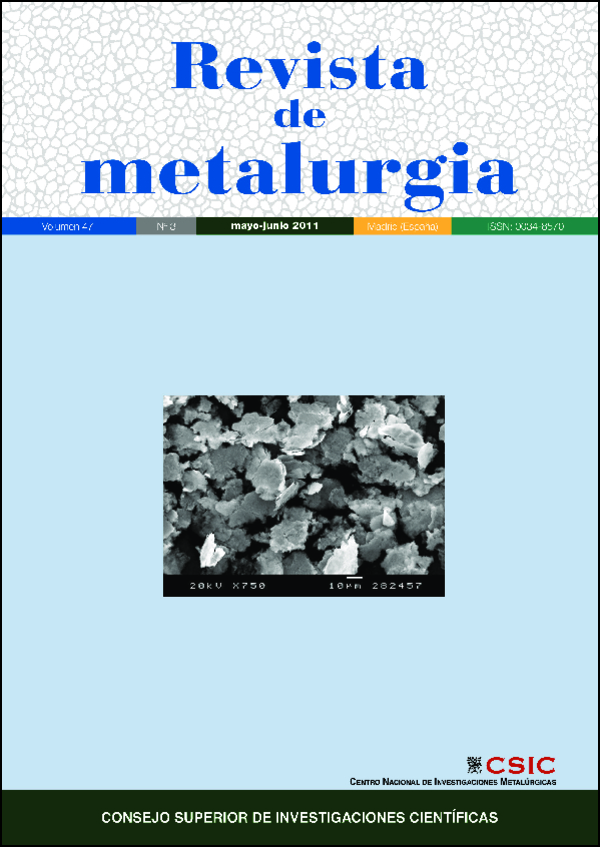Mechanical milling of a nanostructured ductile iron powder under dry, wet and cryogenic atmospheres
DOI:
https://doi.org/10.3989/revmetalm.1028Keywords:
Mechanical milling, Plastic deformation, Nanostructure, XRD, Scanning electron microscopyAbstract
The main objective of this study, is to obtain an effective particle and grain size reduction of a nanostructured iron powder by mechanical milling under different milling media. One of the main challenges in this study is to work with this material of great ductility.The variables of the study to be optimized have been the following: speed of rotation, powder to ball ratio (PBR) and the percentage of control agent to induce an effective powder fracturing in front of cold welding. The powder has been characterized by a Laser Diffraction Particle Size Analyser, scanning electron microscopy (SEM) and transmission electron microscopy (TEM) and, X-ray diffraction.Through the comparative study, it is found that operating under dry milling conditions: there is a more effective particle size reduction of 43 % and grain size reduction of 62 %. In wet conditions has been reduced the amount of oxide, as well as to obtain a more homogenous distribution of the resulting powder. The results under cryogenic media is presented as promising.
Downloads
References
[1] L. Austin y F. Concha: “Diseño y simulación de circuitos de molienda y clasificación”, Universidad Técnica Federico Santa María Ediciones, 1ª Ed., Chile 1994, pp. 1-174.
[2] A. Zaluska, L. Zaluski y J.O. Ström-Olsen, J. Alloy. Compd. 288 (1999) 217-225.
[3] D.L. Huber, Small 5 (2005) 482-501. http://dx.doi.org/10.1002/smll.200500006 PMid:17193474
[4] L. Li, M. Fan, R.C. Brown, J. (Hans) Van Leeuwen, J. Wang, W. Wang, Y. Song y P. Zhang, Critical Reviews, Environ. Sci. Technol. 36 (2006) 405-431. http://dx.doi.org/10.1080/10643380600620387
[5] B. Cullity, Introduction to magnetic materials, Addison-Wesley, Reading, Massachussetts: Addison-Wesley Publishing Company (1972).
[6] M.E. McHenry, M.A. Willard y D.E. Laughlin, Prog. Mater. Sci. 44 (1999) 291-433. http://dx.doi.org/10.1016/S0079-6425(99)00002-X
[7] K. Takadate, A. Kojima, A. Makino y A. Inoue, Scripta. Mater. 44 (2001) 1.401-1.405.
[8] S. Takaki, K. Kawasaki e Y. Kimura, J. Mater. Proc. Technol. 117 (2001) 359-363. http://dx.doi.org/10.1016/S0924-0136(01)00797-X
[9] T.R. Malow y C.C. Koch, Metal. Mater. Trans. A, 29A (1998) 2.285-2.295.
[10] J.J. Suñol, A. González, L. Escoda y M.T. Mora, Rev. Metal. Madrid 44 (2008) 216-221.
[11] C. Suryanarayana, Prog. Mater. Sci. 46 (2001) 1-184. http://dx.doi.org/10.1016/S0079-6425(99)00010-9
[12] D. Chen, S. Ni y Z. Chen, China Particuology 5 (2007) 357-358. http://dx.doi.org/10.1016/j.cpart.2007.05.005
[13] E.J. Lavernia, B.Q. Han y J.M. Schoenung, Mater. Sci. Eng. A 493 (2008) 207-214. http://dx.doi.org/10.1016/j.msea.2007.06.099
[14] D.B. Witkin y E. J. Lavernia, Prog. Mater. Sci. 51 (2006) 1-60. http://dx.doi.org/10.1016/j.pmatsci.2005.04.004
[15] L. Cabrera, S. Gutierrez, N. Menéndez, M.P. Morales, P. Herrasti, Magnetite nanoparticles: Electrochemical synthesis and characterizacio, Electrochemica, Acta 53, 8 (2008) 3.436-3.441.
Downloads
Published
How to Cite
Issue
Section
License
Copyright (c) 2011 Consejo Superior de Investigaciones Científicas (CSIC)

This work is licensed under a Creative Commons Attribution 4.0 International License.
© CSIC. Manuscripts published in both the printed and online versions of this Journal are the property of Consejo Superior de Investigaciones Científicas, and quoting this source is a requirement for any partial or full reproduction.
All contents of this electronic edition, except where otherwise noted, are distributed under a “Creative Commons Attribution 4.0 International” (CC BY 4.0) License. You may read the basic information and the legal text of the license. The indication of the CC BY 4.0 License must be expressly stated in this way when necessary.
Self-archiving in repositories, personal webpages or similar, of any version other than the published by the Editor, is not allowed.
















